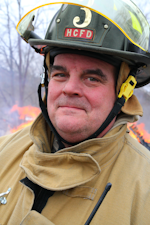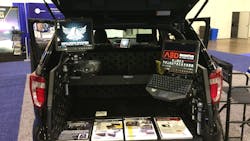Mobile Tech Can Keep Responders Safer
Mobile computing devices in fire apparatus and emergency response vehicles have become ubiquitous as responders rely on the technology and the information they unlock at the scene and in non-emergency situations alike.
There was a time when firefighters relied solely on intuition, experience and limited radio communications. While those remain important tools and skill sets, they have been augmented substantially by electronic information and computers, both apparatus mounted and combination units that can be used outside the apparatus as well.
Stuart Schneider, director of sales and marketing for Patrol PC in North Attleboro, MA, said the No. 1 reason to have computers in apparatus and response vehicles is to get information to responders quickly.
“First and foremost, information is the reason to have a computer, and how do I get that information to my firefighters,” Schneider said. “I have to determine what is wrong and to do that, I might need a building map, especially if I have never seen it before and don’t know where to go.”
Patrol PC makes ultra-rugged touch screen tablet computers exclusively for fire, EMS and police applications from scratch, Schneider said.
He said the tablets created by Patrol PC not only provide quick access to maps and building schematics, they also provide a means to allocate and manage response vehicles, personnel and other assets.
Schneider said the tablets also provide a variety of additional information, including information about hazardous materials and how to handle hazmat incidents.
“Seconds count,” Schneider said. “If I get to a scene and I’ve got a bunch of drums of stuff and don’t know what it is, I need to figure that out quickly.”
Computers Help with 'Chores'
Computers can also assist with routine chores and maintenance items, like turnout gear management and wash cycles, and building inspections as tablets do not necessarily need to remain attached to response apparatus.
“Our first responders are more reliant on mobile technologies than ever just to increase their operational safety and situational awareness,” said Kay Stewart, Panasonic’s director of mobility sales, west. “Having situational awareness is key to the way they perform their jobs.
Stewart said Panasonic, maker of the iconic Toughbook, has been providing mobile computing devices and mobile data computers for the past 20 years and has developed robust products for responders by listening to their needs and desires.
“MCDs or MDCs are important for many reasons to first responders,” Stewart said. “They provide critical information about situations. They provide real-time visibility and they greatly improve on scene communications.”
Stewart said first responders operate in very dynamic environments and real-time information is important to keep them situationally aware of everything that’s happening around them.
Scene videos, CAD information, automatic vehicle location, geographic information systems, and a host of other critical information is readily available to responders, Stewart said.
“Having all those things at your fingertips provides a good view of situational awareness,” Stewart said. “That’s all about keeping not only the first responders safe, but also the public around them. It just makes the scene safer.”
Stewart said Panasonic has a diverse portfolio of products, including laptops, tablets and handheld devices, all designed to help first responders do their jobs more efficiently and safely.
“Years ago, we talked about specific hardware and the functionality of the laptop itself,” Stewart said. “Now, over the past 20 years, there’s conductivity and there’s interoperability and there’s wireless and there’s FirstNet.”
She added there is so much more than just hardware that goes into providing solutions for responders, and Panasonic can not only provide the systems, but the advice and technical assistance to make all the technology work together seamlessly.
“There are so many things that go into a first responder’s solution that, after 20 years, we feel like we’ve listened and we understand,” Stewart said.
Tablets are Coming on Strong
Schneider said tablets for firefighters and fire departments is currently the fastest growing sector in Patrol PC’s portfolio.
That’s why the company created the Fire Tablet, a product they created solely for the fire service, building every piece of the equipment from the motherboard to the modems to the rugged cases and screens.
“We have a very unique product that we only sell to first responders,” Schneider said. “We don’t have any other customers. We are a dedicated, purpose-built, mission critical equipment house,”
Schneider said because all of Patrol PC’s components are built in the United States, it allows the company to create “a very mission-specific platform that is really geared toward what these guys are doing.”
Because Patrol PC’s computer is tablet-based, it allows the firefighters to be totally mobile for use of the camera to take photos of fire scenes or bad crashes, and to bring the technology right to the scene to be immediately available. In some cases, photos of injuries transmitted to emergency rooms will allow doctors and surgeons to mobilize and prepare for the patients before they arrive for care, he said.
The Patrol PC’s screen is “ultra-rugged” and built as an industrial product from scratch with an extremely bright screen to be seen in direct sunlight and strong enough to take a hammer blow.
The tablet also has a bar code scanner to inventory and maintain everything from equipment to trucks and turnout gear, Schneider said.
When looking for computers for apparatus and response vehicles, Schneider said, it’s important to get something that is going to do the jobs responders require and be durable to withstand the rigors of emergency service duty.
Durable Docking
When it comes to docking in apparatus, Schneider said the locking mechanisms should be rock solid with no risk of becoming disconnected while traversing rough roadways.
“With ours, you could take the fire truck over a jump like Evel Knievel and it won’t come undocked,” Schneider said.
Schneider said having a built-in modem for connectivity is important, as well as a user-friendly keyboard that permits easy report typing and the flexibility of being undocked for portability.
Having the ability to connect to a printer is also important, he said, when reports and information need to be converted into hard copies.
And when it comes to mobile technology, Schneider says size does matter. Responders need equipment that is large enough to use comfortably and have screens that are large enough to view. However, sometimes computers can be large and cumbersome, sometimes with fixtures and handles that can become snag hazards which make scenes less safe for responders, he said. Therefore, responders want to have equipment with sleek designs.
“You don’t want anything that firefighters in full turnout gear can get hooked on as they jump in and out of the trucks, “ he said. “Make sure there’s nothing to get hooked on."
Considering all the benefits and avoiding some of the pitfalls can make emergency responses much safer and efficient, Schneider said.
“If you have information and you don’t access it, who is the fool then,” Schneider said. “I don’t get it. If I can make my firefighters safer, I am going to do that.”
Technology is Worth the Price
Schneider said there’s plenty of technology out there today that is reliable and works well. And it’s not extraordinarily expensive, either, he said.
“Most fire trucks are now over a half million dollars for the cheapest ones,” he said, adding that by comparison, a $7,000 computer is system is “nothing.”
“All the tradition in the fire service is wonderful, but I think it’s time to use what’s available out there,” he said. “If you have a chance to do the job better, safer and faster and save more lives, save more property and serve the taxpayers in the process with a product that is going to last 10 years at least, why not use it?
"If you have the information and you don’t use it and somebody gets killed, that’s bad. If someone loses as father, a brother, or a husband, that’s bad, too, and you don’t want that to happen. …The people who aren’t embracing technology now are just being pigheaded.”

Ed Ballam
Ed Ballam served as associate editor for Firehouse. He is the assistant chief of the Haverhill Corner, N.H. Fire Department, and a National Registered EMT. He is also a Deputy Forest Fire Warden for the New Hampshire Division of Forests and Lands. Professionally, he's been a journalist for over 35 years working for a variety of publications, including employment as managing editor of a national fire service trade journal for more than a decade.








